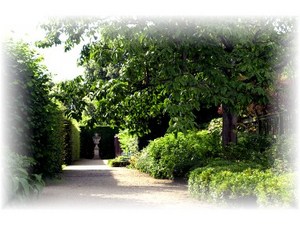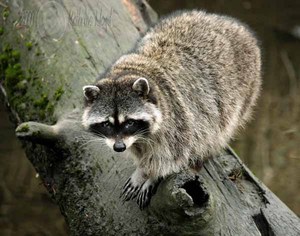Just moving right outside of town and near a small creek, I discovered that I had raccoons for neighbors, and they had discovered me; or should I say my garden. Having a fenced in backyard, I could never figure out what was digging in my freshly tilled soil until I found a raccoon’s calling card (droppings) one morning. I know raccoons love field or sweet corn, but I hadn’t planted any, so what were they after?
Raccoons are crafty fellows having paws that can manipulate the most intricate of items, such as the latch on a garden gate. The adults range in weight from 10 to 30 pounds and can grow up to 40 inches long. Their fur is a mixture of black, gray and brown colors and they have a very distinct ringed tail and a black mask on the face. Mating in February and March, the female will produce a litter of three to five babies after about 65 days gestation period. The young stay with their mother through their first winter, not leaving to be on their own until the following spring.
Raccoons are nocturnal animals, doing their pilfering at night. They are normally not social animals, except during mating season or the raising of their young. They have been known to share dens during cold spells for body warmth when they hibernate, which is only for a few days at a time when the weather is really cold.
The diet of the raccoon consists mainly of mice, bugs, eggs, crayfish, fish, and your garden delicacies. Their paws allow them to climbs, open garbage cans and other containers, spring traps for bait, and much more. One early morning my son once found four small raccoons in the bottom of his trash can outside his back door. They had climbed up the porch steps, jumped in the open, empty trash can and then couldn’t get back out. He just tipped it over and ran. The raccoons quickly escaped to a nearby wooded area. He learned to leave the lid on the trash can after that.
Although the raccoon’s garden choice is corn, they will also eat melons and grubs. That is what they were after in my garden. They were looking for grubs in my newly tilled soil. They have also been known to tear up freshly laid sod looking for grubs. Signs that a raccoon is the culprit for your destroyed garden crops are easy to see, if you know what to look for. Tracks of the raccoon look like tiny human foot prints. Look for those first. Bent over stalks of corn and melons that have a hole in the side and pulp removed as if it were scooped out is another sign of raccoons. There is also the sign they left me, their droppings. How do I know it was a raccoon and not a dog? Our fence is built so that a dog cannot enter and we have no dogs in the area. Raccoon dropping are small, black and ringed.
Keeping raccoons away from your crops is not an easy task, but there are some things you can try. Pick your corn a little early before the raccoons get to it; they have an uncanny sense of timing, knowing exactly when corn is ripe for the picking.
Repellents such as leaving your dirty clothes in the garden, dog droppings or red fox urine are great for keeping raccoons as bay. Sprinkle baby powder on and around plants, raccoons hate the stuff.
Timed flood lights, windmills, pie pans that clang in the wind have also been known to drive raccoons away. A fence is also a good defense, if you have the right kind; unlike me that has a six foot wooden fence with a small along the bottom. A good raccoon fence is constructed of four foot chicken wire, no support along the top and with 12 inches of the fence top bent outward. As the raccoon nears the top, it bends downward, and his weight causes him to drop to the ground.
If you have tried everything you can think of, the only option you have left is to try trapping them. Be mindful thought, that these are clever animals and you may come out to find your trap sprung and bait gone.
The raccoon does have natural enemies such as the dog, fox, coyote, weasel, and horned owl, but other than the dog, they tend to only go after the young raccoons.
Source: Life Cycle of the Raccoon, by John Crossingham



